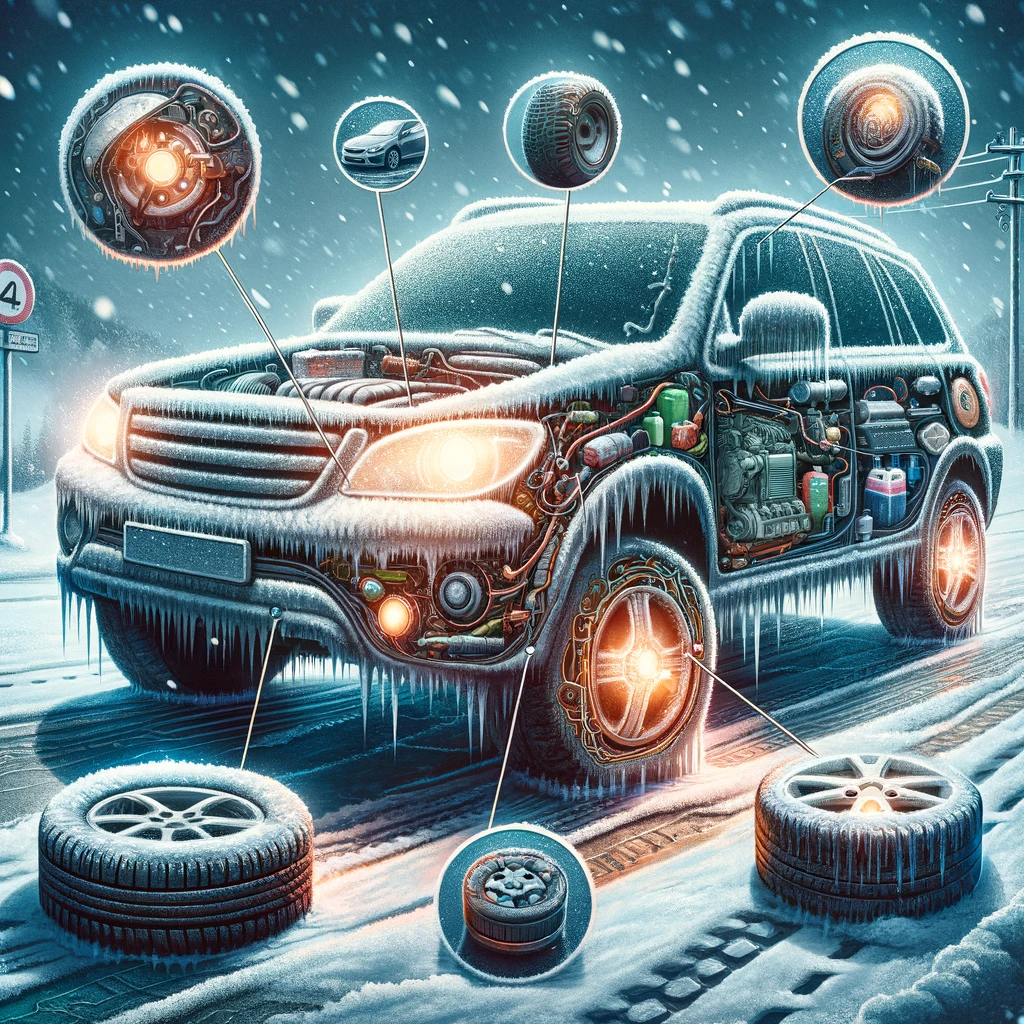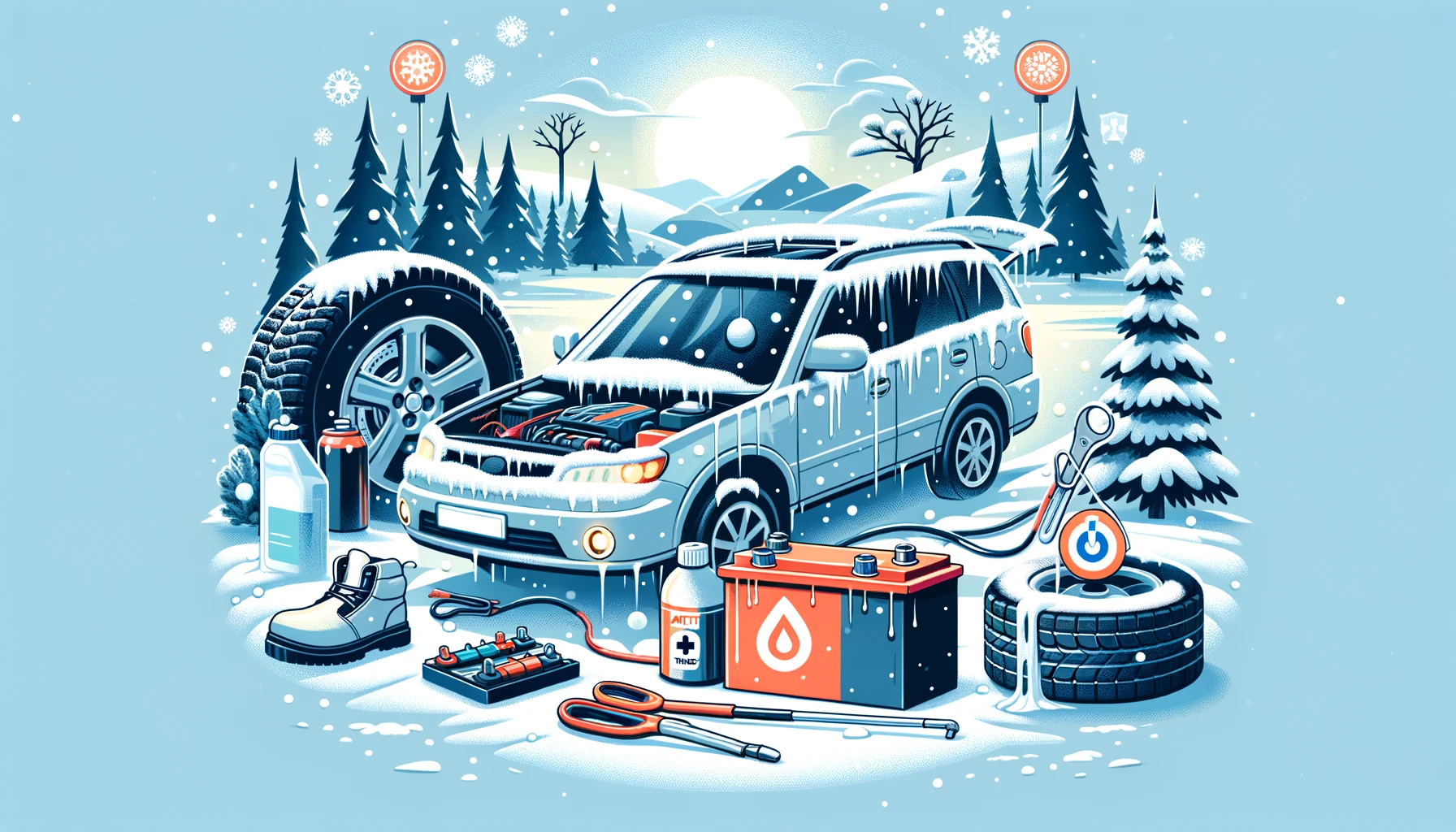When it comes to winter car maintenance, the stakes are high. As the mercury dips, your car faces a host of challenges that can affect its performance and longevity.
Understanding the Impact of Cold Weather on Your Vehicle
Thickening of Fluids
One of the most significant effects of cold weather on your vehicle is the thickening of fluids. Fluids like engine oil, transmission fluid, and brake fluid are essential for the smooth operation of various car systems. In cold temperatures, these fluids can become more viscous, or thicker. This change in viscosity means that the fluids do not flow as freely as they should, making it harder for your engine and transmission to operate efficiently.
Strain on the Battery
Cold weather can also put a considerable strain on your car’s battery. Batteries rely on chemical reactions to generate power, and these reactions slow down in colder temperatures. As a result, your battery may not provide enough power to start your engine. This issue is compounded because the engine requires more energy to start when its fluids are thicker. Also, the battery’s capacity to hold a charge decreases in cold weather, making it more prone to dying.

Tire Pressure Fluctuations
Another aspect often overlooked is the impact of cold weather on tire pressure. Tires tend to lose pressure in colder temperatures, which can lead to decreased traction and increased wear. Driving with under-inflated tires can also affect the fuel efficiency of your vehicle and may pose a safety risk.
Impact on Electrical Systems
The electrical systems in your car, such as the headlights, windscreen wipers, and heater, are also more heavily used during winter. This increased usage can put additional strain on the battery and the alternator, which may lead to premature wear.
Freezing Point of Fluids
The freezing point of various fluids in your vehicle is another critical consideration. For instance, the windshield washer fluid should be of a type that does not freeze in winter temperatures to ensure visibility is not compromised. Similarly, the coolant should have the correct mixture of anti-freeze to prevent it from freezing in the radiator or engine block.
Corrosion and Rust
Lastly, winter conditions, particularly in areas where roads are salted to prevent ice, can accelerate the rusting and corrosion of your vehicle’s undercarriage and body. Salt and other de-icing chemicals are corrosive, and over time, they can damage the metal components of your vehicle.
Understanding these impacts is crucial for effective winter car maintenance. By preparing for these challenges, you can ensure your vehicle remains in good working order throughout the colder months.
Tips for Protecting Your Car in Winter
Winter demands both proactive and reactive measures for car maintenance. To ensure smooth operation and safety, here are some structured tips:
Regular Maintenance Checks
Regular maintenance checks are essential. Here’s a breakdown of key areas to focus on:
| Maintenance Area | Details |
|---|---|
| Oil Changes | Opt for thinner, winter-grade oil to ensure proper lubrication in cold temperatures. |
| Fluid Levels and Types | Check and maintain the levels of transmission fluid, brake fluid, and coolant. Use fluids suitable for lower temperatures. |
| Battery Check | Test battery charge and replace if necessary. Keep terminals clean. |
| Tire Inspection and Rotation | Use winter tires or all-season tires with good tread. Regularly check and adjust tire pressure. |
| Brake System Check | Ensure brakes are in good working order for icy conditions. |
| Heating and Defrosting Systems | Verify the efficiency of the heater and defroster for comfort and visibility. |
| Lighting Check | Ensure all lights are functional for improved visibility in shorter, darker days. |
Proactive Measures
| Measure | Purpose |
|---|---|
| Underbody Wash | To prevent rust and corrosion from road salt. |
| Waxing | Protects the paint from road salt and grime. |
Reactive Measures
| Measure | Components |
|---|---|
| Emergency Kit | Should include a blanket, extra clothing, flashlight, shovel, and a first-aid kit. |
| Roadside Assistance | Advisable to have a plan, especially in winter months. |
Following these guidelines not only ensures your vehicle’s smooth operation but also significantly enhances safety during winter. Properly maintained cars are better equipped to handle harsh winter conditions and are less prone to problems.
The Role of Anti-Freeze in Winter Car Care
Anti-freeze plays a critical role in vehicle maintenance, especially during the winter months. Its primary function is to prevent the engine’s cooling system from freezing, which is essential for maintaining your car’s performance in cold weather.
How Anti-Freeze Works

Anti-freeze, often mixed with water, lowers the freezing point and raises the boiling point of the liquid in the engine’s cooling system. This dual function ensures that the engine operates efficiently by preventing the coolant from freezing in cold temperatures and from overheating in warmer conditions.
Preventing Engine Damage
The engine cooling system is designed to maintain an optimal operating temperature. In winter, if the coolant freezes, it can lead to significant engine damage, including cracked components and burst pipes. Anti-freeze circulates through the engine and absorbs heat, helping to prevent these issues.
Corrosion Inhibition
Many anti-freeze formulations also contain corrosion inhibitors. These additives help protect the engine and cooling system components from rust and corrosion, which can be accelerated by temperature fluctuations and the use of road salts in winter.
Choosing the Right Anti-Freeze
Selecting the appropriate anti-freeze for your vehicle and local climate is crucial.
- Vehicle Manufacturer’s Recommendation: Always refer to your vehicle’s manual for the manufacturer’s recommendations on anti-freeze type. Using the wrong type can lead to decreased efficiency and potential damage.
- Anti-Freeze Types:
- IAT (Inorganic Additive Technology): Typically green in color, used in older models.
- OAT (Organic Acid Technology): Often orange, yellow, red, or green, used in many modern vehicles.
- HOAT (Hybrid Organic Acid Technology): A combination of IAT and OAT, used in some European and Korean cars.
- Climate Considerations: The anti-freeze mixture ratio can vary depending on the climate. In extremely cold areas, a higher proportion of anti-freeze to water may be required.
- Regular Replacement: Anti-freeze should be replaced as per the schedule recommended by your vehicle’s manufacturer. Over time, the effectiveness of the anti-freeze can diminish.
By understanding the vital role of anti-freeze and choosing the right type for your vehicle and climate, you can significantly enhance your car’s winter performance and longevity. Regular checks and maintenance of the anti-freeze levels and quality are essential parts of winter car care.
Keeping Your Car Battery Charged in Cold Weather
Cold weather significantly impacts car batteries, making it essential to maintain and monitor them during winter. Here’s a detailed look at how to keep your car battery charged and the signs of battery wear:
Tips for Maintaining Battery Charge
| Maintenance Tips | Description |
|---|---|
| Regular Checks | Use a volt meter to regularly check your battery’s charge level. |
| Clean Connections | Ensure battery terminals are free from corrosion to improve electrical conductivity. |
| Battery Charger | Use a battery charger or maintainer to keep the battery charged, especially if the car will be idle. |
| Limit Short Journeys | Short trips can drain the battery; combine errands into fewer, longer trips. |
| Park in a Garage | Parking in a garage can protect the battery from extreme cold temperatures. |
Signs of Battery Wear
| Signs of Wear | What to Look For |
|---|---|
| Dimming Headlights | Headlights that are dimmer than usual, particularly at startup. |
| Slow Engine Crank | A car that takes longer to start, with the engine cranking slowly. |
| Electrical Issues | Flickering dash lights or malfunctioning electronic components. |
| Swollen Battery Case | A battery case that appears swollen or distorted. |
| Battery Age | Batteries typically last 3-5 years; older batteries are more likely to fail in cold weather. |
Understanding these aspects and monitoring your car’s battery can help you avoid battery-related issues during winter. Regular checks and maintenance are crucial for ensuring reliability in cold conditions.
Concluding Thoughts on Winter Car Maintenance
As we wrap up our journey through the essentials of winter car care, let’s revisit the key takeaways that will help keep your vehicle running smoothly through the colder months:
- Regular Maintenance: Frequent checks and timely maintenance are paramount. Remember to monitor fluids, battery health, tire pressure, and overall vehicle functionality.
- Understanding the Cold: Recognizing how winter affects your car’s performance is crucial. This includes the thickening of fluids, strain on the battery, and increased wear on tires and brakes.
- The Role of Anti-Freeze: Never underestimate the importance of anti-freeze. It is vital in preventing your engine’s cooling system from freezing and maintaining optimal performance.
- Battery Care: Keeping your car battery charged and healthy during winter ensures your vehicle starts reliably and functions efficiently.
- Proactive Measures: From parking in a garage to using a battery maintainer, proactive steps can significantly enhance your car’s winter readiness.
We hope this article has equipped you with valuable insights and practical tips for winter car care. Your vehicle is more than just a means of transportation; it’s a companion that needs care, especially in challenging conditions.
For more insightful articles and tips on car maintenance and care, don’t forget to visit our blog. We continuously update it with valuable information to help you keep your car in top condition.
Lastly, if you found this article helpful, we encourage you to share it with your friends and family. Spreading knowledge is key to helping more people navigate the winter season safely and efficiently with their vehicles.
Stay safe and happy driving!
